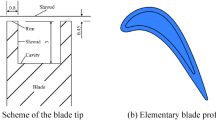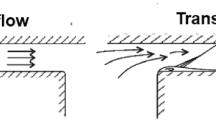Abstract
In this paper, the aero-thermal performance of squealer tips with deep-scale depth is numerically investigated in an axial flow turbine, which is compared with the squealer tip with traditional cavity depth. Numerical methods were validated with experimental data. The effect of cavity depth and tip clearance was considered. The numerical results show that for the squealer tip with conventional cavity depth, the size of the reflux vortex enlarges as the cavity depth increases. The velocity and uniformity of high entropy production rate (EPR) inside the cavity reduce obviously with the cavity develo** into deep-scale. However, the increase of depth 10% of the blade span (H) leads to enlargement of cavity volume, which increases the total entropy production rate. And the overall dimensionless entropy production rate (DEPR) of gap and cavity obtains a maximum increase of 43.54% in contrast to the case with 1%H depth cavity. As a result, the relative leakage mass flow rate reduces by 20.6% as the cavity depth increases from 1% to 10%. Given the heat transfer, as the cavity significantly increases to 10%H, the enhanced cavity volume results in a more enormous cavity vortex with low velocity covering the floor, which weakens the convective heat transfer intensity and reduces the area of high heat transfer. The normalized average heat transfer coefficient at the cavity bottom reduces by 40.26% compared to the cavity depth of 1%H. In addition, the deep-scale cavity is more effective in inhibiting leakage flow at smaller tip clearance. The reduction amplitude of normalized average heat transfer coefficient at the squealer floor decreases as tip clearance increases, which reduces at most by about 72.6% for the tip clearance of 1%H.
Similar content being viewed by others
Abbreviations
- C ax :
-
axial chord of the blade
- C p :
-
static pressure loss coefficient
- d i :
-
depth of the squealer
- H :
-
span of the blade
- h :
-
heat transfer coefficient
- h ave :
-
area-averaged heat transfer coefficient
- Nu :
-
Nusslet number
- Q :
-
Heat flux
- s̄ ij :
-
strain rate tensor
- W :
-
width of squealer
- ε :
-
relative leakage mass flow rate
- λ T :
-
turbulent heat transfer coefficient
- μ T :
-
turbulent viscosity coefficient
- τ :
-
tip clearance height
- DEPR:
-
dimensionless entropy production rate
- EPR:
-
entropy production rate
- HPT:
-
high-pressure turbine
- LE:
-
leading-edge of blade
- PS:
-
pressure side of blade
- SS:
-
suction side of blade
- TE:
-
trailing edge of blade
- TKE:
-
turbulent kinetic energy
- TLF:
-
tip leakage flow
- TLV:
-
tip leakage vortex
- TPV:
-
tip passage vortex
- in/out:
-
inlet/outlet of the computational domain
- t:
-
total
References
Bunker R.S., Axial turbine blade tips: function, design, and durability. Journal of Propulsion and Power, 2006, 22(2): 271–285.
Bunker R.S., A review of turbine blade tip heat transfer. Annals of the New York Academy of Science, 2001, 934(1): 64–79.
Sun Q., Ji D., Guo H., Research on gas turbine blade material and Fatigue Creep. Turbine Technology, 2017, 59(2): 81–83.
Booth T.C., Dodge P.R., Hepworth H.K., Rotor-tip leakage Part I: basic methodology. ASME, 1981, Paper 81-GT-71.
Yamamoto A., Interaction mechanisms between tip leakage flow and the passage vortex in a linear turbine rotor cascade. Journal of Turbomachinery, 1988, 110(3): 329–338.
Denton J.D., Loss mechanisms in turbomachines. Journal of Turbomachinery, 1993, 115(4): 621–656.
Azad G.S., Han J.C., Teng S., et al., Heat transfer and pressure distributions on a gas turbine blade Tip. Journal of Turbomachinery, 2000, 122(4): 717–724.
Kwak J.S., Han J.C., Heat transfer coefficients of a turbine blade-tip and near-tip regions. Journal of Thermophysics & Heat Transfer, 2003, 17(3): 297–303.
Azad GM.S., Han J.C., Bunker R.S., Lee C.P., Effect of squealer geometry arrangement on a gas turbine blade tip heat transfer. Journal of Heat Transfer, 2002, 124: 452–459.
Zeng F., Du J., Huang L., et al., An experimental method for squealer tip flow field considering relative casing motion. Chinese Journal of Aeronautics, 2020, 33(7): 1942–1952.
Zeng F., Zhang W., Wang Y., et al., Effects of squealer geometry of turbine blade tip on the tip-leakage flow and loss. Journal of Thermal Science, 2021, 30(4): 1376–1387.
Zhou C., Hodson H., Numerical investigation of thermal performance of unshrouded HP turbine blade tips. International Journal of Turbo & Jet Engines, 2009, 26(4): 277–284.
Kavurmacioglu L., Maral H., Senel C.B., et al., Performance of partial and cavity type squealer tip of a HP turbine blade in a linear cascade. International Journal of Aerospace Engineering, 2018, Article: 3262164.
Yang H., Ching H., et al., Turbine rotor with various tip configurations flow and heat transfer prediction. Journal of Thermophysics & Heat Transfer, 2006, 20(1): 80–91.
Liu J.J., Li P., Zhang C., et al., Flow field and heat transfer past an unshrouded gas turbine blade tip with different shapes. Journal of Thermal Science, 2013, 22(2): 128–134.
Zhong J., Wu W., Han S., Research progress of tip winglet technology in compressor. Journal of Thermal Science, 2021, 30(1): 18–31.
Cui W., Wang X., Yao F., Zhao Q., Liu Y., Liu L., Wang C., Yang L., Effects of width variation of pressure-side winglet on tip flow structure in a transonic rotor. Journal of Thermal Science, 2022, 31(1): 141–150.
Zou Z., Shao F., Li Y., et al., Dominant flow structure in the squealer tip gap and its impact on turbine aerodynamic performance. Energy, 2017, 138: 167–184.
Zou Z., Xuan L., Chen Y., et al., Effects of flow structure on heat transfer of squealer tip in a turbine rotor blade. International Communications in Heat and Mass Transfer, 2020, 114: 104588.
Kim J., Seo W., Chung H., et al., Effect of shelf squealer tip configuration on aerothermal performance of gas turbine blade. International Journal of Thermal Sciences, 2021, 168: 107056.
Yan X., Huang Y., He K., et al., Numerical investigations into the effect of squealer-winglet blade tip modifications on aerodynamic and heat transfer performance. International Journal of Heat & Mass Transfer, 2016, 103: 242–253.
Choi S.M., Bang M., Moon H., et al., Wake effects on heat transfer from a turbine blade tip with different configurations and its corresponding shroud. International Communications in Heat and Mass Transfer, 2021, 126: 105333.
Du K., Li Z., Li J., et al., Influences of a multi-cavity tip on the blade tip and the over tip casing aerothermal performance in a high-pressure turbine cascade. Applied Thermal Engineering, 2019, 147: 347–360.
Jiang S., Li Z., Li J., et al., Effects of the novel rib layouts on the tip leakage flow pattern and heat transfer performance of turbine blade. Proceedings of the Institution of Mechanical Engineers Part G: Journal of Aerospace Engineering, 2020, 234(8): 1446–1459.
Lee S.W., Chae B.J., Effects of squealer rim height on aerodynamic losses downstream of a high-turning turbine rotor blade. Experimental Thermal & Fluid Science, 2008, 32(8): 1440–1447.
Zhou C., Effects of endwall motion on thermal performance of cavity tips with different squealer width and height. International Journal of Heat and Mass Transfer, 2015, 91: 1248–1258.
Shi W., Chen P., Li X., et al., Uncertainty quantification of the effects of squealer tip geometry deviation on aerothermal performance. Proceedings of the Institution of Mechanical Engineers Part A Journal of Power and Energy, 2020, 234(7): 1026–1038.
Kwak J., Ahn J., Han J., Effects of rim location, rim height, and tip clearance on the tip and near tip region heat transfer of a gas turbine blade. International Journal of Heat and Mass Transfer, 2004, 47(26): 5651–5663.
Zhou C., Hodson H., Squealer geometry effects on aerothermal performance of tip-leakage flow of cavity tips. Journal of Propulsion and Power, 2012, 28(3): 556–567.
Park J., Lee D., Rhee D., et al., Heat transfer and film cooling effectiveness on the squealer tip of a turbine blade. Energy, 2014, 72: 331–343.
Sakaoglu S., Kahveci H.S., Effect of cavity depth on thermal performance of a cooled blade tip under rotation. International Journal of Heat and Mass Transfer, 2019, 143: 118561.
Bang M., Choi S., Sohn H., et al., Effects of unsteady wakes on heat transfer of blade tip and shroud. International Communications in Heat and Mass Transfer, 2018, 97: 125–135.
Senel C.B., Maral H., Kavurmacioglu L.A., et al., An aerothermal study of the influence of squealer width and height near a HP turbine blade. International Journal of Heat & Mass Transfer, 2018, 120: 18–32.
Kwak, J.S., and Han, J.C., Heat transfer coefficient on a gas turbine blade tip and near tip regions. AIAA-2002-3012, 2002. DOI: https://doi.org/10.2514/6.2002-3012.
Timko L.P., Energy efficient engine high pressure turbine component test performance report, 1984.
Moore J., Moore J.G., Entropy production rates from viscous flow calculations: Part I A turbulent boundary layer flow. Proc. ASME 1983 International Gas Turbine Conference and Exhibit, 1983, V001T001A032. DOI: https://doi.org/10.1115/83-gt-70.
Kwak J., Han J., Heat transfer coefficient on the squealer tip and near squealer tip regions of a gas turbine blade. Journal of Heat Transfer, 2003, 125(4): 669–677.
Ye M., He K., Yan X., Influence of wear damages on aerodynamic and heat transfer performance in squealer tip gap. Applied Thermal Engineering, 2019, 159: 1–19.
Ameri A.A., Steinthorsson E., Rigby D.L., Effect of squealer tip on rotor heat transfer and efficiency. Journal of Turbomachinery, 1998, 120(4): 753–759.
Yang D.L., Feng Z.P., Tip leakage flow and heat transfer predictions for turbine blades. Proceedings of ASME Turbo Expo, 2007, ASME, Paper GT2007-27728.
He K., Investigation of film cooling and heat transfer on a turbine blade squealer tip. Applied Thermal Engineering, 2017, 110: 630–647.
Li F., Wang H., Liu Z., et al., Comparisons of blade tip phantom cooling effectiveness for two tip structures with three tip clearances. Applied Thermal Engineering, 2022, 202: 1–14.
Acknowledgements
The authors gratefully acknowledge the financial supports for the project from the National Science and Technology Major Project of China (2017-III-0010-0036), China Postdoctoral Science Foundation (NO.2020TQ0147) and Natural Science Foundation of Jiangsu Province (NO. BK20200454).
Author information
Authors and Affiliations
Corresponding author
Rights and permissions
About this article
Cite this article
Bi, S., Wang, L., Wang, F. et al. Effect of Squealer Tip with Deep Scale Depth on the Aero-thermodynamic Characteristics of Tip Leakage Flow. J. Therm. Sci. 31, 1773–1789 (2022). https://doi.org/10.1007/s11630-022-1683-4
Received:
Published:
Issue Date:
DOI: https://doi.org/10.1007/s11630-022-1683-4




